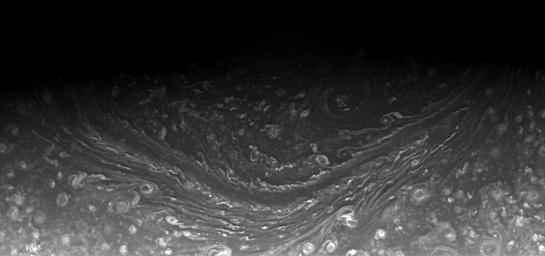
|
The Persistent Hexagon
- Click the image above for a larger view
- Full-Res JPEG (1016 x 477) (51.5 kB)
- Full-Res TIFF (1016 x 477) (485.3 kB)
Caption:
Saturn's north polar hexagon appears to be a long-lived feature of the atmosphere, having been spotted in images of Saturn in the early 1980s, again in the 1990s, and then by the Cassini spacecraft in the past several years.
The persistent nature of the hexagon in imaging observations implies that it is present throughout Saturn's 29-year seasonal cycle. Two sides of the hexagon are seen here.
This view was obtained from about 67 degrees above the equator. The image was taken with the Cassini spacecraft wide-angle camera on Aug. 25, 2008 using a spectral filter sensitive to wavelengths of infrared light centered at 752 nanometers. The view was acquired at a distance of approximately 566,000 kilometers (352,000 miles) from Saturn. Image scale is 31 kilometers (19 miles) per pixel.
Background Info:
The Cassini-Huygens mission is a cooperative project of NASA, the European Space Agency and the Italian Space Agency. The Jet Propulsion Laboratory, a division of the California Institute of Technology in Pasadena, manages the mission for NASA's Science Mission Directorate, Washington, D.C. The Cassini orbiter and its two onboard cameras were designed, developed and assembled at JPL. The imaging operations center is based at the Space Science Institute in Boulder, Colo.
For more information about the Cassini-Huygens mission visit http://saturn.jpl.nasa.gov/ . The Cassini imaging team homepage is at http://ciclops.org .
Cataloging Keywords:
| Name | Value | Additional Values |
|---|---|---|
| Target | Saturn | |
| System | Saturn | |
| Target Type | Planet | |
| Mission | Cassini-Huygens | |
| Instrument Host | Cassini Orbiter | |
| Host Type | Orbiter | |
| Instrument | Imaging Science Subsystem (ISS) | |
| Detector | Wide Angle Camera | |
| Extra Keywords | Atmosphere, Grayscale, Infrared, Visual | |
| Acquisition Date | ||
| Release Date | 2008-10-08 | |
| Date in Caption | 2008-08-25 | |
| Image Credit | NASA/JPL/Space Science Institute | |
| Source | photojournal.jpl.nasa.gov/catalog/PIA10486 | |
| Identifier | PIA10486 | |
